Managing School Infrastructure
Overview
School infrastructure—comprising assets such as classrooms and sports, arts and physical activity spaces—has been shown to be an important part of achieving educational outcomes, along with ongoing improvements to curriculum and teaching styles. The condition and design of school assets can also affect the overall health and safety of students, staff and visitors.
In this audit, we assessed whether the Department of Education and Training (DET) is effectively planning for and managing school infrastructure. We considered DET’s role in planning for and managing government primary and secondary school assets. We did not look at Catholic and other independent schools, pre-primary, tertiary, language or specialist schools.
We make seven recommendations directed to DET.
Managing School Infrastructure: Message
Ordered to be published
VICTORIAN GOVERNMENT PRINTER May 2017
PP No 253, Session 2014–17
President
Legislative Council
Parliament House
Melbourne
Speaker
Legislative Assembly
Parliament House
Melbourne
Dear Presiding Officers
Under the provisions of section 16AB of the Audit Act 1994, I transmit my report Managing School Infrastructure.
Yours faithfully

Andrew Greaves
Auditor-General
11 May 2017
Audit overview
The Department of Education and Training (DET) administers Victoria's education system. It is responsible for establishing, running and maintaining government schools, which cater for about 63 per cent of school-age Victorians.
School infrastructure—comprising assets such as classrooms and sports, arts and physical activity spaces—is an important part of achieving educational outcomes.
About 60 per cent of Victoria's current government school buildings have been built since 1992 and are therefore less than 30 years old. School buildings need to be functional to meet the needs of contemporary educational programs. They also need to be well maintained to ensure the health and safety of students, staff and visitors are prioritised and to avoid costly repairs and reconstruction.
In June 2016, there were 1 544 government schools, including 29 463 'sub‑buildings'. DET counts sub-buildings rather than whole buildings, to account for parts of buildings being built at different times and constructed of different materials. DET's property portfolio makes up 16 per cent of the value of Victoria's state-owned assets—it is one of the largest state-owned asset portfolios in Victoria.
Since the 1990s, each Victorian school has been responsible for administering and managing its own assets. Victoria is considered to be one of the most devolved government school sectors in Australia.
Since 2011, Victoria has experienced rapid population growth. The Victorian Government's report Victoria in Future 2016 projects that the school-aged population of five to 17 year olds in Victoria will increase by around 90 000 students—nearly 10 per cent—between 2017 and 2022. Taking into account the potential capacity of existing schools, DET predicts that 50 additional government schools will need to be built by 2021 to meet this growing demand.
In 2012, DET assessed the overall condition of existing government school buildings in Victoria. Although it found that the buildings were in 'good' condition overall, 34 per cent of building elements were rated as below 'good', requiring repair and replacement. This assessment and multiple reviews at the time highlighted that the condition of school buildings in 2012 was the result of a lack of maintenance planning, underinvestment, limited accountability of school leaders for asset maintenance, and differences in school leaders' capability in managing assets.
Since the 2012 assessment, DET has been subject to reviews and audits of its management of the government school asset portfolio. These include the Victorian Government review of government schools' funding, a Victorian Government inquiry into schools' devolution and accountability, and our audits of school infrastructure. DET has also conducted its own investigations to understand the reasons behind the condition of school assets.
DET has actively responded to our findings and those of others by developing a 10‑year asset strategy and a package of asset management reforms. These reforms aim to improve:
- DET's capacity to strategically invest in high-priority maintenance projects
- transparency and certainty over how DET allocates maintenance funding
- schools' accountability in managing their own assets
- capability of school leaders to manage their assets.
Victorian Government Asset Management Framework
The Victorian Government provides policy and guidance to agencies responsible for state-owned assets through its Asset Management Framework. This framework outlines the steps agencies must take to make sure their assets meet their service delivery objectives efficiently and effectively.
The framework includes the Asset Management Series, produced in 1995, which provides guidance for agencies to meet their objectives. This will be replaced by the Asset Management Accountability Framework when it comes into effect from 1 July 2017. The new guidance outlines mandatory elements that DET and other agencies will have to report against annually.
In this audit, we assessed whether DET has effectively planned for and managed school assets.
Conclusion
DET has made considerable progress since our last audits in 2008 and in 2013, and its recent focus on improving its long-term planning through its 10-year Asset Strategy 2014–24 (the asset strategy) is encouraging. These reforms are largely sound. However, this work is not yet complete, and the scale of reform required is significant. Much work remains for DET to establish effective asset management arrangements for its school assets.
Through its asset strategy, DET is redesigning how it is planning for and managing Victoria's government schools. It is improving the transparency and rigour of funding allocations for schools, working with schools to improve their individual asset management planning, and improving the skills of school leaders in managing assets.
DET is effectively planning to meet the growing demand for new school places. It is also working towards providing schools and local councils with the opportunity to strategically plan ahead by extending the investment planning and budgeting cycle from one to five years.
Weaknesses remain in how DET holds schools accountable for their role in managing school assets. School maintenance continues to be underfunded and is at levels below industry standards. As a result, schools will continue to postpone much-needed repairs and struggle to maintain their assets effectively. As DET is ultimately accountable for Victoria's government schools, this compromises its ability to effectively manage school assets under its control.
Findings
Strategic asset management planning
DET has all the elements of a strategic asset management framework for managing school assets but needs to do further work to make this framework fully effective.
DET's Asset Strategy 2014–24 provides the necessary high-level strategic planning for school assets. However, key accountability mechanisms are missing.
The roles and responsibilities of school councils and principals in relation to school infrastructure are unclear. Performance expectations, established by the performance indicators in DET's asset strategy, need to be reconsidered, as only half of the eight measures are currently being monitored and two are yet to be developed.
DET's school building design guidelines outline the need for 21st-century learning environments—flexible and adaptable spaces with up-to-date facilities and technology that fulfil each space's designated functionality. However, DET lacks functional performance measures that will help it to determine whether each school's assets meet this need.
DET lacks oversight of school councils and how they hold their principals to account for managing their assets.
DET has required schools to develop their own asset maintenance plans since it devolved responsibility for school management to the schools themselves in the 1990s.
Since 1994, DET has required school principals, through their contracts, to develop, implement and manage a plan for maintenance of school buildings and grounds. To date, DET has not provided clarity to schools on what these plans are to include and has therefore not been able to hold schools to account for the completion or adequacy of the plans. As a result, asset maintenance plans have not been prepared for every school.
Since 2013, DET has required schools undertaking capital and major maintenance projects to prepare asset management plans. It provided templates and a manual to guide schools. However, these plans have focused on project delivery, not on the ongoing scheduled maintenance activities.
As a result, effective mechanisms for holding schools to account are missing. DET's reforms aim to address these gaps. It is working to:
- establish appropriate governance arrangements
- clarify the role of principals
- hold school leaders to account
- manage the consequences of underperforming schools.
DET is also updating its templates and manuals and will be requiring all schools to develop a comprehensive asset maintenance plan over the next five years. Due to the critical need for the school and school leaders to 'own' the plans they will implement, this five-year time frame is realistic.
Asset acquisition planning
DET forecasts the number of additional school places that will be required 20 years into the future. In 2015–16, DET adopted a new forecasting approach that gives it a more detailed picture of predicted enrolment trends. This has allowed DET to better project future demand for enrolment places for various demographic planning areas.
DET compares these predicted enrolment trends with existing school places to identify the enrolment shortfall over a 20-year period and develops the new schools pipeline as advice to government on priority schools to be built.
As raised with DET in the Auditor-General's Report on the Annual Financial Report of the State of Victoria 2013–14, DET does not retrospectively test the accuracy of its forecasts and therefore does not know how their reliability changes over time.
DET has worked effectively with planners of the new metropolitan growth corridors to plan ahead for the location of future schools. However, planning in established areas has proved to be more complex, due to the scarcity of available land, high traffic congestion and the increasing density of developments, which further limits options for schools to expand.
Until new schools are built, DET has used relocatable buildings to respond effectively to changing enrolment demand and the need for assets. These buildings can be removed when a school no longer needs them and then refurbished and relocated. DET considers the individual asset needs of schools annually to accommodate changes in enrolments.
DET's ability to provide future certainty of funding and work with local councils strategically and collaboratively on planning multi‑use, shared or co-located facilities is limited by the annual funding allocation process. This process, combined with government's decisions about which new schools to build outside of DET's prioritisation process, means that DET is unable to pre-empt government decisions on which new schools will be funded.
This is a significant hurdle to achieving the benefits of well-designed co-planned facilities. Planning partners need sufficient time to conduct their own planning and budgeting processes. The opportunity for DET to work together with local governments on the design of facilities is typically limited to only three to six months.
Managing existing school assets
DET has made considerable progress since our last audit in 2013, which found gaps in DET's long-term planning and life cycle planning, and the accountability mechanisms in place between DET and schools.
Management information systems
To date, DET's oversight of school asset management practices and outcomes has been limited.
DET is addressing this by improving its asset registers to clearly and accurately identify the number and value of the school assets it controls. It is also improving its ability to inform itself and schools of the performance of school assets by developing an asset information management system, which will hold a wide range of information and is designed to be the 'single source of truth' for both DET and schools. The system will be rolled out to schools progressively from 2017.
Asset condition
DET's knowledge of the condition of its school assets is out of date. Its 2012 condition assessment was the first comprehensive survey of the condition of school assets.
DET intends to improve the way it routinely assesses the condition of these assets by introducing a rolling facilities evaluation, expected to start in 2017. This information will build on the 2012 condition assessment and identify ongoing priority maintenance projects across Victoria.
Asset performance
DET is on track to meet four of the eight performance indicators included in its asset strategy. However, it does not monitor the remaining four indicators relating to compliance, access and community inclusion. Two of these indicators are yet to be developed. DET does not report on performance against the indicators.
DET has also removed all known high-risk categories of asbestos from Victorian government schools.
Asset maintenance
The government allocates funding for school maintenance as part of the annual State Budget cycle. DET distributes the bulk of these funds to schools for maintenance of their assets. It holds a portion of these funds centrally to address the maintenance backlog identified in the 2012 condition assessment.
DET has improved the objectivity and transparency of the way it allocates maintenance funding. It has worked with schools to address priority projects from the maintenance backlog. However, maintenance funding continues to be below DET's assessment of industry standards. Without sufficient funding, schools will continue to postpone repairs and struggle to maintain their assets cost-effectively. DET is therefore limited in its ability to raise the condition of assets to more cost-effective levels.
Recommendations
We recommend that the Department of Education and Training:
- complete the delivery of funding, capability, accountability and portfolio efficiency reforms currently underway, as detailed in Appendix B
- clarify governance arrangements by specifying the asset planning and management roles and responsibilities of the Department of Education and Training, school councils and principals, their functions and the performance measures they will be held accountable for, and hold them accountable (see Section 2.2.2)
- establish a monitoring and evaluation framework for the asset strategy based on a complete set of performance measures that are specific, measurable, achievable, relevant and timely, that inform the goal of the asset strategies, and that are routinely monitored and reported on (see Section 2.3.1)
- test the accuracy of its provision planning forecasting over short-, medium- and long-term projections to understand its reliability over time (see Section 3.2.1)
- establish guidelines to inform its decisions for managing changing enrolments in established areas—considering school locations, purchasing of land ahead of when it is required, access issues for students, and size of school land (see Section 3.2.2)
- work with local councils and other partners, particularly in growth areas, to strategically plan and design multi-use, shared and co-located facilities before new schools are funded through state budgets (see Section 3.4)
- develop an investment strategy for government school assets to optimise maintenance over the entire life of assets, considering the appropriate mix of allocations for proactive and reactive maintenance, and the implications of current maintenance funding on the life cycle of school assets (see Section 4.5).
Response to recommendations
We have consulted with the Department of Education and Training, and we considered its views when reaching our audit conclusions. As required by section 16(3) of the Audit Act 1994, we gave a draft copy of this report to the Department of Education and Training and asked for its submissions and comments. We also provided a copy to the Department of Premier and Cabinet.
The following is a summary of DET's response. The full response is included in Appendix A.
The Department of Education and Training accepts our recommendations and has developed an action plan to address them.
1 Audit context
1.1 Government school infrastructure in Victoria
The Department of Education and Training (DET) administers Victoria's education system, which comprises government and independent schools. DET is responsible for establishing, running and maintaining government schools.
The infrastructure assets under DET's control include school classrooms and sports, arts and physical activity spaces.
In June 2016, DET was responsible for 1 544 government schools, which included 29 463 'sub‑buildings'. DET counts sub-building rather than whole buildings, to account for different parts of buildings being older than others and constructed of different materials. Approximately 20 per cent of DET's school buildings are relocatable. They constitute around 10 per cent by area, as relocatable buildings are typically smaller than permanent buildings.
About 60 per cent of Victoria's current government school buildings have been built since 1992 and are therefore less than 30 years old, as shown in Figure 1A. DET's records do not show the original build date of about 6 per cent of government school buildings.
Figure 1A
DET's school buildings by year built, 1850 to 2016
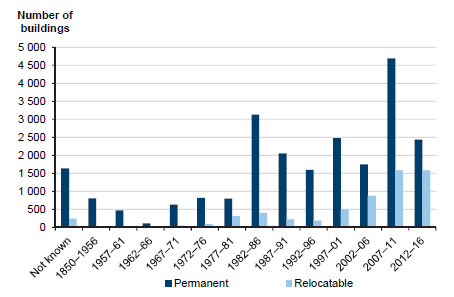
Note: The figure only includes data on buildings used for curriculum purposes. Non-curriculum buildings include relocatable buildings in storage.
Source: VAGO, based on data from DET.
According to DET's 2015−16 financial statements, government school buildings form part of DET's $19.87 billion property, plant and equipment portfolio—including $9.37 billion of land and $10.5 billion of buildings, improvements, plant and equipment, and work in progress. DET's property portfolio makes up 16 per cent of the value of Victoria's government-owned assets and is one of the largest state-owned asset portfolios in Victoria.
Between 2007 and 2012, the state and Commonwealth governments invested $4.5 billion in new buildings through the Victorian Schools Plan and the Building the Education Revolution initiative. These programs collectively included new schools, the replacement of small rural schools and upgrades to existing buildings across the state.
DET last assessed the condition of Victoria's government school assets in 2012. The assessment looked at elements of buildings. As shown in Figure 1B, it found that 66 per cent of building elements were at or above good condition, scoring between 3.5 and 5 on a five-point rating. Building elements rated below 'good' require attention and repair.
The building element ratings were averaged at a building and school level. The assessment found that 68 per cent of buildings and 70 per cent of schools were rated at or above good condition.
The assessment was guided by minimum acceptable thresholds for core buildings, non-core buildings and other site infrastructure—see Section 4.3.1. Building elements found to be below these thresholds required repairs or replacement and were classified as part of the maintenance backlog.
Figure 1B
Condition of school assets, at 2012, as a percentage of all school assets

Source: VAGO, based on data from 2011–12 Condition Assessment of all State Schools in Victoria: Strategic Action Management Plan, Department of Education and Early Childhood Development, 2013.
DET provides places at government schools for all Victorian students who choose a public education. In 2016, 63 per cent of school-age Victorians attended government schools—around 575 000 students. This includes over two-thirds of all primary students and over half of all secondary school students.
Although schools are initially planned for a long-term enrolment of 450 students for a primary school and 1 100 for a secondary school, these figures are far from reality in some areas—23 per cent of primary schools and 27 per cent of secondary schools are much larger. The largest primary school has about 1 400 students and the largest secondary school has about 2 000 students. By contrast, around 300 primary schools and four secondary schools are considerably under the planned enrolment level, with fewer than 100 students.
DET is responding to the ongoing changes in demand for places in government schools.
Changing trends
During the late 1990s, DET consolidated and closed schools in response to declining enrolments in government schools, as shown in Figure 1C. This trend was the result of declining birth rates, Victorians leaving the state, and students leaving the government school sector.
By 2011, enrolment numbers in government schools were on a different trajectory. Increased birth rates and immigration have resulted in significant growth in enrolments in government schools.
Victoria is now growing faster than any other jurisdiction in Australia. The Victorian Government's Victoria in Future 2016 data projects that the school-aged population of five to 17 year olds in Victoria will increase by around 90 000 students—nearly 10 per cent—between 2017 and 2022. DET predicts that approximately 66 per cent of primary school students and 56 per cent of secondary school students across Victoria will choose a government school education. These proportions vary across different locations.
DET has since been addressing shortfalls in available government school places by increasing the number of buildings at existing schools, or by building new schools. Taking into account potential capacity within existing schools, DET anticipates that 50 additional government schools will be needed by 2021 to meet this growth.
Figure 1C
Growth in Victorian school enrolments, actual and projected, from 1986 to 2036
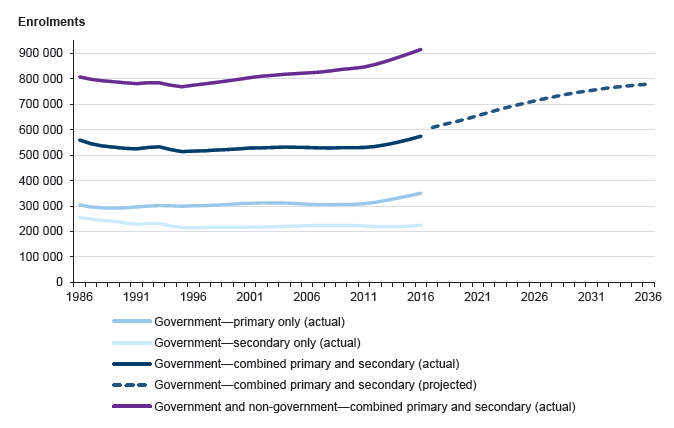
Note: Figures beyond 2016 are projected.
Source: VAGO, based on data from DET.
Demand for individual schools is also affected by the choices that parents make. The guiding legislation for Victorian schools—the Education and Training Reform Act 2006 (the Act)—provides a right for every school-age child to enrol at his or her neighbourhood government school. It also allows students to choose other government schools where there is available space.
DET's planning aims to facilitate this choice. It works with schools to determine available space and uses a fleet of relocatable buildings to provide schools with the flexibility to meet the peaks in demand.
DET's Asset Strategy 2014–2024 (the strategy) guides how it plans for and manages school assets. DET refreshed the strategy in 2016 and is due to evaluate it in 2017.
1.2 Roles and responsibilities
The Minister for Education (the minister) is responsible for the Act.
Departmental
DET is responsible for delivering education directly through government schools and indirectly through the regulation and funding of non-government schools and programs. It is responsible for establishing, running and maintaining Victorian government schools and ensuring that their assets are managed efficiently and effectively. DET is also responsible for ensuring that there are enough government school places to meet changing enrolment trends.
In July 2016, the revised Standing Directions of the Minister for Finance (the Standing Directions) clarified expectations for DET in its role as the responsible agency. The Standing Directions required DET to impose an appropriate level of financial management accountability, governance and compliance on school councils.
As school councils collectively manage state assets of significant value, the Standing Directions highlighted that it is appropriate for DET to subject them to sophisticated asset management requirements, proportionate to the collective value of the assets they manage.
In August 2016, DET set up the Victorian School Building Authority (VSBA) to deliver the government's education investment program. VSBA was formed from an existing division of DET rather than being established as an administrative authority under the Public Administration Act 2004. Authorities established under the Public Administration Act 2004 have the same functions as a head of department—providing advice directly to the relevant minister. However, VSBA continues to function as a division of DET.
School councils
Since the 1990s, Victorian schools have operated under a devolved model of asset management, which gives schools responsibility for managing and maintaining their own assets. The model recognises that schools are best managed locally so that their unique needs can be met. Victoria has one of the most devolved models for the government school sector in Australia.
The Act establishes school councils as body corporates. Their objectives include assisting in the efficient governance of schools, and they are responsible for developing a vision for the school through a strategic school plan. The Act also requires school councils to report on schools' financial activities.
School councils are directly accountable to the minister for 'exercising general oversight of the school buildings and grounds, and ensuring they are kept in good order and condition'.
Principals are executive officers of the school council and are therefore accountable to the school council. At the same time, they are DET employees and represent DET on the school council. DET allocates responsibility for strategic management of resources to principals through their employment contracts.
1.3 Victoria's asset policy framework
The Victorian Government developed the Asset Management Framework to guide responsible agencies to meet their service delivery objectives efficiently and effectively. A practical reference guide—Asset Management Series—was introduced in 1995, and the high‑level policy objectives were set out in Sustaining Our Assets, introduced in 2000.
In February 2016, the government announced the introduction of the Asset Management Accountability Framework(AMAF) to establish a set of requirements for agencies managing public asset portfolios. Components of the AMAF are mandatory. It will replace the previous high‑level policy objectives and practical reference guide when it comes into effect from 1 July 2017.
From the 2017–18 financial year, the Secretary of DET will be required to demonstrate DET's compliance with the AMAF annually—for the entire period of the relevant financial year—in DET's annual report. Every three years, the Secretary will be responsible for assessing DET's asset management maturity against the requirements.
The government acknowledges that agencies will need a transition period before they can fully comply with all mandatory elements of the AMAF.
1.4 Reviews of management of school assets
DET's management arrangements for school assets have been increasingly scrutinised since the condition assessment conducted in 2012.
Following the assessment, DET commissioned a review in 2013 to understand the reasons behind the degraded condition of school assets.
We conducted an audit in 2013—Implementation of School Infrastructure Programs—as a follow up to our 2008 audit School Buildings: Planning, Maintenance and Renewal.
Our audits and the DET review found that the effective management of school buildings was being compromised by:
- poor long-term strategic and asset management planning
- limited oversight and accountability for outcomes and spending of funds
- lack of transparency in how funds are prioritised and distributed
- underfunding of maintenance below industry standards
- differences in the capability of schools to manage their own assets.
DET followed up these findings with its own internal audits, which further found that DET had limited oversight of the investments managed by schools.
We audit DET's accounting for school infrastructure annually as part of our financial audit. In 2013–14, we qualified our opinion on DET's financial report because we disagreed with DET's approach to devaluing excess space. This devaluation was based on DET's premise that a school received no value from the spaces that exceeded what the school was entitled to, both at the time and seven years ahead.
One consequence of the devaluation of excess space was significantly less funding available to DET for asset maintenance. The Auditor-General's Report on the Annual Financial Report of the State of Victoria 2013–14 provides more detail about this issue.
DET has since addressed its accounting approach in line with our concerns.
1.5 Department of Education and Training reforms
DET has actively responded to findings of recent reviews and audits, and is in the process of rolling out a set of reforms. These focus on four key areas, as shown in Figure 1D and detailed in Appendix B—funding, capability, accountability and efficiency across the portfolio. These reforms are considered throughout the report.
Figure 1D
DET's accountability improvement reforms
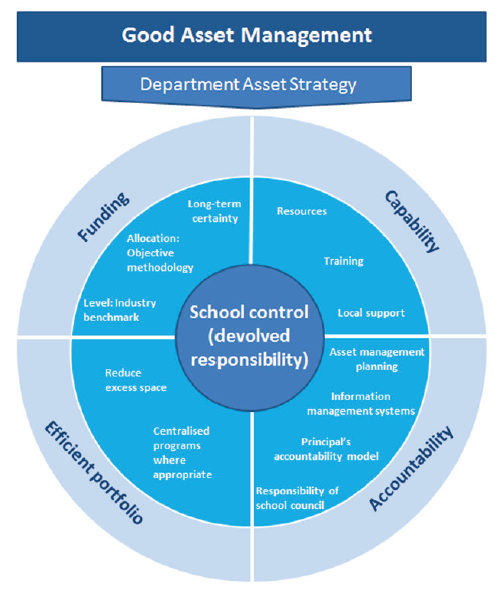
Source: DET.
Once fully implemented and effective, these initiatives should enable DET to improve the adequacy of its oversight of schools' asset management and to meet its accountability to the minister.
1.6 Why this audit is important
School infrastructure is important for supporting educational outcomes. Access to high‑quality, well-maintained 21st-century facilities can influence students' literacy and numeracy.
Ineffective management of school assets can:
- compromise educational outcomes
- be more costly in the long term
- adversely affect the health and safety of students, staff and visitors.
We have previously found significant gaps in DET's planning for and management of Victorian government school assets. This audit aimed to determine whether these gaps have been addressed.
1.7 What this audit examined and how
Our objective was to determine whether DET is effectively planning for and managing school infrastructure.
We considered DET's role in planning for and managing government primary and secondary school assets. We did not look at Catholic and other independent schools, or pre-primary, tertiary, language or specialist schools.
We also looked at how well DET interacts with other relevant planning authorities and organisations such as the Metropolitan Planning Authority, local government councils, the Department of Environment, Land, Water and Planning, and Places Victoria.
This audit was conducted in accordance with section 15 of the Audit Act 1994 and the Australian Auditing and Assurance Standards. The total cost of the audit was $685 000.
1.8 Report structure
The remainder of the report is structured as follows:
- Part 2 assesses DET's strategic asset management planning
- Part 3 assesses DET's asset acquisition planning
- Part 4 assesses how DET manages existing school assets.
2 Strategic asset management planning
A strategic planning framework is integral to an agency's ability to make sound business decisions and effectively meet its obligation to be fully accountable. It is the mechanism through which an agency outlines its objectives, sets its performance targets, identifies strategies and actions, and allocates resources and responsibilities.
To achieve its objectives, an agency needs sound project planning. It must also monitor and evaluate whether its activities are achieving the desired outcomes.
This Part of the report examines the effectiveness of the Department of Education and Training's (DET) strategic asset management planning for school infrastructure.
2.1 Conclusion
DET has made considerable progress in its planning and management of school infrastructure since our previous audits in 2008 and in 2013. DET's focus on improving its long-term planning through its asset strategy is encouraging.
Through its Asset Strategy 2014−2024 (asset strategy), DET is changing how it plans and manages Victoria's government schools and how it works with schools to improve asset management planning. It is also working to improve the asset management capability of school leaders.
These reforms are largely sound. However, these actions are not yet complete, and the scale of the reform is significant. Much work remains for DET to establish effective asset management arrangements for school infrastructure.
Weaknesses remain in how DET holds schools accountable for their role in managing school assets. This compromises DET's ability to plan and manage the assets under its control.
2.2 Asset governance and accountability
Governance arrangements should clearly establish responsibility for performance of, and accountability for, the agency's assets and the services being delivered. They should include how the agency will acquire, use, maintain and account for the assets under its control.
Since the 1990s, Victorian schools have operated under one of the most devolved models for the government school sector in Australia. Although schools are responsible for managing their own assets, DET is ultimately accountable to the Minister for Education (the minister) for school assets under its control.
A devolved model needs to be matched with appropriate governance arrangements. Models focusing on compliance alone can discourage schools from adopting the constructive behaviours that would enable them to meet their devolved responsibilities. The most effective model is one that combines compliance with other mechanisms that focus on transparency and sharing of information—with the aim of encouraging those involved to adapt and improve policies, services and behaviours.
Between 2011 and 2013, multiple audits and reviews—both internal and external to DET—identified that DET had weak accountability mechanisms. Although DET had devolved management and budgets to schools, it had not effectively established financial controls or implemented a program to hold schools accountable for their performance and outcomes.
In 2013, we recommended that DET require schools to adopt a long-term approach to maintaining assets and hold them to account for doing so.
In the same year, the former Victorian Competition and Efficiency Commission (VCEC)—now the Office of the Commission for Better Regulation—held an inquiry to analyse options for improving governance and accountability. Its report Inquiry into School Devolution and Accountability stated that 'increasing school autonomy and accountability could contribute to realising the top-tier performance goal—as long as it focuses on improving school leadership and teaching, and provides schools with more flexibility to tailor services to the needs of their students and communities'.
According to the report, there are some generally recognised principles and practices that should underpin any particular accountability regime, including:
- clarity and coherence of objectives
- clear and aligned accountabilities and authorities
- access to necessary skills, experience and resources
- timely flow of information and robust performance reporting.
DET has introduced a package of reforms targeted at improving its accountability for school assets. We assessed these reforms against the principles and practices identified by the VCEC report, as detailed below.
We recognise that under a devolved model, it is important that school leaders have ownership of these changes, and that this takes time.
2.2.1 Clarity and coherence of objectives
An important component of devolved accountability models is a shared vision that outlines how performance will be measured.
According to the asset strategy, an effective education system should ensure that assets foster 21st-century learning, are in good condition and are managed efficiently and effectively. This will enable a greater focus on teaching and learning.
Although DET's asset strategy establishes measures to assess performance of school assets, DET is not monitoring or reporting on them and they lack a true measure relating to operational performance—see Section 2.3.1. This limits DET's and schools' ability to determine how effectively school assets are meeting contemporary teaching and learning needs.
2.2.2 Clarity and alignment of accountabilities and authorities
A devolved accountability model must have clear and aligned accountabilities and authorities. This is not the case for the management of Victoria's government school assets.
As outlined in Part 1, both DET and school councils have direct accountability to the minister for ensuring the quality and condition of school assets.
DET is accountable to the minister for the assets under its control—for ensuring that these assets are managed efficiently and effectively to meet service delivery objectives. School councils are accountable to the minister for their functions defined in the Education and Training Reform Act 2006. These include 'to exercise general oversight of the school buildings and grounds and ensure that they are kept in good order and condition'. These lines of accountability are shown by the unbroken lines labelled A and B in Figure 2A.
Figure 2A
School accountability structure
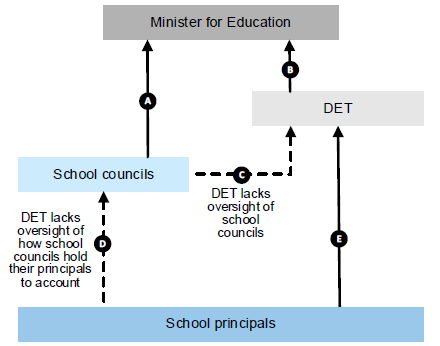
Source: VAGO.
The dual accountability of school councils and DET to the minister can be addressed by the requirements of the July 2016 revised Standing Directions of the Minister for Finance (Standing Directions). These Standing Directions reinforced DET's role in providing assurance to the minister for assets under its control and required DET to have a governance role over school councils—as shown by the dotted line labelled C, between DET and school councils, in Figure 2A. As noted in Part 1, the Standing Directions required DET to impose an appropriate level of financial management accountability, governance and compliance on school councils.
DET has provided some clarity to distinguish roles and responsibilities for school councils and principals. DET communicates through its policies that the role of school councils is to allocate contracts for school cleaning and for building and grounds improvements. However, this role description falls short of the legislative function of school councils of exercising general oversight of school buildings and grounds.
The dual accountability of principals to school councils and also to DET remains, as shown by the lines labelled D and E in Figure 2A. DET has no oversight of the governance structures that school councils establish for their principals and is therefore unable to determine how school councils are holding principals to account for managing school buildings and grounds.
DET has created a direct line of accountability between DET and the principals through their employment contracts. These contracts set out the major educational and managerial functions for which the principal is directly accountable. Notably, since 1994, DET has included a performance requirement in school principals' contracts to 'develop, implement and manage a plan for the development and general maintenance of school buildings and grounds'.
However, to date, DET has not provided clarity to principals on what such plans entailed and could therefore not hold schools accountable for the completion or adequacy of the plans in addressing proactive maintenance planning needs.
In 2013, DET identified limitations in its oversight of school asset management planning. As a result, DET introduced the asset management planning requirement for schools. In order for DET to allocate funding for capital and planned maintenance projects identified through the 2012 condition assessment, schools were required to develop a plan according to a DET template. The limitations of this requirement and DET's review of its performance is discussed in Section 2.3.2.
DET is currently developing a template for schools which focuses on proactive asset maintenance—see Section 2.3.2. It is also improving its information management systems to provide oversight of schools' maintenance activities—see Section 2.2.4.
DET is reviewing its accountability mechanisms to determine how it will hold schools principals accountable for their performance relating to managing school assets.
Developing a middle level of governance
According to the 2013 VCEC report, high-performing schools around the world have a middle-level governance arrangement that significantly contributes to the performance of schools. This governance arrangement aims to facilitate and support collaboration in the delivery of school services, while recognising the differing circumstances and needs of individual schools.
The report identified opportunities to deliver site and facilities management services and physical asset maintenance services more effectively and efficiently through a middle-level arrangement.
DET is piloting a model that involves outsourcing maintenance planning and delivery functions to a supplier at a regional or subregional level. The pilot will involve 50 schools having their assets managed by an external supplier over a period of five years. The pilot is intended to test the costs and benefits of an outsourced model for asset maintenance and is expected to provide better value than each school managing its own maintenance.
2.2.3 Access to necessary skills, experience and resources
The effectiveness of devolved accountability models relies on access to appropriate skills, experience and resources.
DET has progressively improved access for principals and other school leaders to training in asset management to enable and empower informed local decision‑making.
DET has implemented a professional development and technical leadership program for principals and other school leaders. The program provides an overview of day‑to‑day asset and financial management and targets identified knowledge gaps and areas of complexity. This training was formally introduced in the first term of 2014 and now runs about 20 times a year across the state.
In 2015, DET's internal audit found weaknesses in principals' asset management capabilities. Although training is offered to all principals, school leaders and school staff, only 53 per cent of principals surveyed had completed asset management training.
DET has made this training compulsory for all schools that receive capital or planned maintenance funding. DET needs to continually work with principals to improve the uptake of training.
DET's regional offices also play a critical role in offering day-to-day support to schools. This support reduced between 2012 and 2013 as a result of the Sustainable Government Initiative, which reduced staffing levels in regional offices.
In response, DET introduced a team of technical leadership coaches, who offered the necessary support to schools. These coaches were former principals and school leaders who were selected for their experience in school infrastructure and asset management, and for their strong stakeholder management skills.
Since 2016, DET has employed more regional staff, which has improved its ability to support schools regionally. Schools can also contact the Victorian Schools Building Authority directly with queries.
DET has also developed a suite of resources including guides and templates to help principals and school leadership teams make informed decisions about asset management and expenditure. These cover the four stages of an asset's life cycle—plan, build, manage and dispose.
2.2.4 Timely information flow and robust performance reporting
A devolved accountability model relies on timely flow of asset information and robust performance reporting.
Asset information includes a wide range of data and information captured in documents, drawings, photographs and assessments. It can include attributes of assets—such as age, materials and the amount of space a school is entitled to—and subjective information about the asset related to its performance. This information can be used to inform decisions.
DET currently has limited oversight over each school's asset management activity and spending on maintenance funding, because there is no timely flow of asset information.
DET is improving its central information management systems to incorporate all information on school assets. It has three systems including:
- an administration, finance and central reporting system, which helps schools provide key data required for central accountability reporting
- a project tracking system, introduced in 2014, which provides information on the financial status and progress of DET-led capital and maintenance projects
- an asset management information system, which acts as a central register of information on land and buildings.
To date, DET's asset management information system has been used internally only and has not captured the information held and managed by schools. It is limited as it currently excludes condition ratings and asbestos risk, joint-use agreements, school maintenance activities, and individual valuations of assets, which are held on separate systems.
DET's reforms aim to improve the management of information about school assets. Actions include:
- updating the system to incorporate all information sources in a central register
- incrementally providing schools with access to the system to be able to incorporate and share information.
DET is progressively rolling out access to the system for schools, with a pilot planned for 2017 involving around 72 schools. This will allow schools to access more comprehensive and up-to-date information about their assets, to help inform their own asset management decisions.
DET also anticipates that these systems will enable it to have up-to-date data on school assets and track how schools use their maintenance funding.
The effectiveness of these reforms relies on schools being able to access the system remotely and use it effectively. It will also rely on DET implementing an effective accountability framework to ensure schools use the system.
2.3 Planning for school assets
The Victorian Government's practical reference guide for asset managers is provided in the Asset Management Series (AMS). The AMS specifies that secretaries are responsible for the development of:
- an asset strategy—including planning over the assets' lifecycle (acquisitions, operations, maintenance and disposal) and funding
- five-year asset management plans—covering maintenance, refurbishment and energy management, and including all operating costs
- annual asset management plan—listing in detail the maintenance tasks to be performed each year.
DET is responsible for the strategic asset planning through its asset strategy and has devolved asset management planning to individual schools.
This guide is to be replaced by the Asset Management Accountability Framework (AMAF) when it comes into effect from 1 July 2017.
The AMAF will require planning that takes into account:
- short term—one to three years
- medium term—four to nine years
- long term—10 or more years.
The AMAF states that departments are accountable for management of the assets under their control.
2.3.1 Department of Education and Training's strategic asset planning
DET has a 10-year asset strategy with a goal to 'develop and maintain a high‑performing asset base that supports world-leading education and development outcomes'. It provides the appropriate long-term strategic planning. DET anticipates that short- and medium-term planning will be provided through individual schools' five‑year asset management and maintenance plans when they are all developed.
The asset strategy provides adequate direction for management of schools' assets. It:
- develops an asset portfolio to support service delivery
- sets asset management priorities
- undertakes gap analysis to identify differences between the existing and required assets
- identifies asset-related risks that may potentially affect service delivery
- sets asset performance levels needed to achieve efficient service performance
- provides the basis for the more detailed asset management plans (AMP)—acquisition plan, operations plan, maintenance plan and disposal plan.
DET's asset strategy lists six strategic responses—shown in Figure 2B—aim to respond to statewide infrastructure challenges, provide transparency and certainty about how spending is prioritised, and improve the efficiency and sustainability of the asset base. It also lists 16 actions with 49 associated progress milestones to meet the objectives.
Figure 2B
Strategic responses in DET's asset strategy
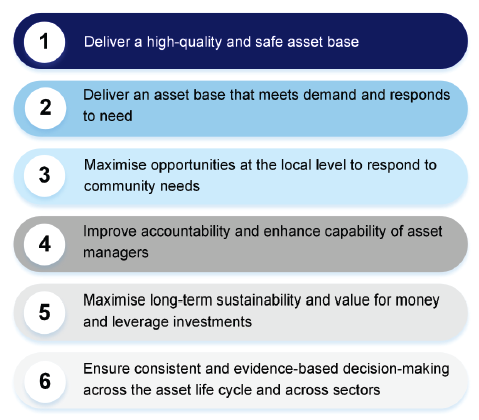
Source: VAGO based on DET Asset Strategy 2014–24.
The asset strategy is supported by a range of operational policies that guide DET's and schools' decisions on asset management. Like DET's guidance and templates, these policies address the four necessary stages of asset management—planning, acquisition, operation and disposal.
The asset strategy specifies that DET will monitor its performance against the strategy and revise it every three years or as required. DET refreshed the asset strategy in 2016 and will complete the first three-year review of its performance against the strategy in 2017. However, this review will be limited by incomplete monitoring data—see Section 4.3.
Asset management objectives and performance measures
In order to assess how effectively Victorian government school assets support teaching and learning outcomes, DET needs to have clear objectives. These need to be accompanied by key performance indicators that DET can use to track and assess its performance. This will help to improve accountability for asset management.
The AMS specifies that secretaries of departments are accountable for the planning, management and performance of assets. The Secretary of DET must ensure that schools perform to an agreed standard and that systems and processes are in place to monitor asset performance.
The AMS and the AMAF provide guidance to agencies on the types of performance measures that can be used for managing public assets. These can include the assets':
- operational performance in meeting service delivery objectives
- condition
- utilisation
- functionality
- financial performance
- operating costs.
The DET asset strategy's overall objective is to 'develop and maintain a high‑performing asset base that supports world-leading education and development outcomes'.
It provides DET's first set of performance indicators for government school assets. It details eight performance indicators that are categorised into five 'objective indicators', as outlined in Figure 2C.
DET aims to achieve its performance targets by the end of the asset strategy's term—30 June 2024—but this is only made explicit for indicator 4 (excess space) and indicator 5 (utilities). DET does not specify the time frame during which it will measure the other indicators.
Figure 2C
DET's asset strategy performance indicators
|
Objective indicator |
Performance indicator |
|
|---|---|---|
|
Functionality |
1 |
All schools are rated 3.5 out of 5 (or above) for functionality, with 5 being international best practice. |
|
Condition |
2 |
All schools are rated 3.5 out of 5 (or above) for condition, with 5 being the equivalent of a new asset. |
|
3 |
All schools are deemed to comply with regulations. |
|
|
Efficiency |
4 |
Excess space across the asset base at 15 per cent of total space or less by 30 June 2024. |
|
5 |
15 per cent reduction in utilities consumption across government schools (gas, water and electricity) by 30 June 2024. |
|
|
Access |
6 |
Access measure to be developed as a priority action of the asset strategy (may relate to travel time, capacity in growth areas). |
|
Community inclusion |
7 |
100 per cent of new schools are planned with adequate consideration given to opportunities for co-location with community and/or early learning services. |
|
8 |
Joint use agreement or formal partnership arrangement measure to be developed as a priority action of the asset strategy. |
|
Source: VAGO based on information from DET.
DET's performance indicators need to be reviewed. Despite being in its third year of the asset strategy, DET has not yet developed two of the indicators—indicators 6 (access) and 8 (community inclusion). DET does not report on performance against all asset strategy indicators, as discussed further in Part 4.
Operational performance measures
The AMS states 'the principal objective of asset management is to enable an agency to meet its service delivery objectives efficiently and effectively'. Such objectives relate to the quality of the service delivered and users' satisfaction with service as a result of using the asset.
DET's performance measures lacks such indicators relating to the operational performance of school assets. This limits DET's ability to demonstrate how effectively the assets are meeting contemporary teaching and learning needs.
Service delivery can be measured through an asset's functionality. The AMS highlights that the functionality of an asset is a measure of how well suited the asset is to the activities and functions it supports.
Monitoring and assessing the functionality of an asset involves determining:
- the role the asset plays in achieving service delivery outcomes
- the functional characteristics the asset needs to have, to support the specified activities.
DET currently uses a financial spending measure as a proxy measure of functionality. DET considers that schools that have received high levels of funding in recent years should be in an improved functional state. This assumes schools have used the funding to develop modern 21st-century learning environments that satisfy the needs of staff and students. DET does not test this assumption.
DET's current functionality measure has limited relevance to how well suited an asset is to the activities and functions it supports.
We recognise that this measure is being used as a transparent investment prioritisation tool for allocating funds to projects of greatest need. The information is used, along with the condition rating, to fairly prioritise funding allocations for schools. However, it does not enable DET to measure how effectively school assets are contributing to education outcomes.
DET requires schools receiving capital works funding to complete a functionality assessment of their existing facilities. DET has developed the Victorian Functionality Template to guide schools' self-assessment on the health and functionality of their facilities and determine whether they are fit for purpose, to meet the curriculum needs of the school community.
DET intends to work further with individual schools to complete these functionality assessments as part of their asset management planning.
Although this approach is encouraging, it is currently subjective. DET does not require schools to report against the measures and does not independently verify the assessments. DET is yet to establish objective measures that it can use to measure and report on the extent to which Victoria's school assets foster 21st-century learning.
2.3.2 Schools' asset management planning
The AMS requires DET to ensure that five-year asset management strategies are developed by each school to cover maintenance, refurbishment, energy management and all operating costs. A management strategy is a comprehensive plan that:
- defines the asset, the performance required of it, and the level at which it should be maintained
- describes the systems and procedures that must be used to plan and manage the maintenance work
- specifies the types of maintenance to be carried out, and why
- nominates the means of resourcing and implementing maintenance
- indicates any requirements for in-house plant, equipment and spare parts
- outlines the projected costs of routine, corrective and preventive maintenance
- forecasts major replacements of assets for the next five to 10 years.
Once a five-year asset management plan has been developed, the AMS requires DET to ensure these are translated into annual maintenance plans that set out, in detail, the maintenance tasks to be performed each year.
In the past, DET has expected schools to conduct their own asset management planning. As discussed in Section 2.2.2, DET requires school principals to prepare plans for how they will develop and maintain their buildings and grounds. However, DET has not provided clarity on what such plans should entail and has had limited oversight over asset maintenance planning within schools.
In our 2013 audit of school infrastructure, we recommended that DET require schools to adopt a long-term approach to maintaining assets and hold them to account for doing so.
In the same year, DET started to require schools to develop asset management plans in order to receive funding for capital and planned maintenance projects identified through the 2012 condition assessment. DET provided a template and guidance to schools. These five-year plans support a school's strategic priorities and address priority projects to improve the condition of school buildings.
DET is progressively requiring schools to develop these asset management plans when they receive capital and planned maintenance funding. About 500 government schools—around one-third—currently have an asset management plan in place. The remaining two-thirds of schools—including new schools—are yet to receive project funding and therefore do not have one.
DET commissioned a review in 2016 which highlighted weaknesses in this asset management planning process. It concluded that these plans have focused solely on delivering projects rather than providing the necessary proactive maintenance planning as part of a well-designed maintenance program.
DET's reforms aim to address this weakness by requiring schools to develop an additional asset plan focusing on maintenance to complement the current project‑focused management plans. DET is developing a template and guidance for schools to develop maintenance plans that include maintenance tasks over a five‑year period.
DET intends to require all government schools to have such a plan in place when their assets are assessed as part of the rolling facilities evaluation—see Part 4 and Appendix B. Every school is expected to have an asset maintenance plan in place by 2021.
Improvements to the asset management information systems are expected to give DET oversight of schools' maintenance activities and how they use their maintenance funding.
Although the AMS has required DET to ensure that asset management plans are in place since 1995, covering maintenance, refurbishment, energy management and all operating costs, we recognise the significance of the scale of the task DET needs to undertake.
Due to the critical need for school leaders to own their maintenance plans, we consider the time frame proposed for all schools to have one by 2021 to be reasonable.
Given the long life cycle of school buildings, it is important that the maintenance plans not only consider the immediate five years of maintenance but also incorporate maintenance planning—including activities and costing—for the full life cycle of the assets.
As show in Figure 2D, the costs of an asset vary across its life cycle. An asset's condition will always deteriorate over time and it will require an increasing level of maintenance well beyond five years. These costs can depend on how an asset is designed and built.
Figure 2D
Overview of asset life cycle costs

Source: VAGO.
3 Asset acquisition planning
The Department of Education and Training (DET) is responsible for providing a government school place for every Victorian student who chooses a public education.
Before 2011, the number of students in Victoria was relatively stable. Since then, Victoria's population has experienced significant growth and is projected to keep rising in many areas.
Planning for these changes involves forecasting changes in the number of school-aged children and the proportion likely to choose a public education. It involves managing peak enrolments, considering the readiness and appropriateness of school sites and related assets, and prioritising when and where new schools need to be built.
This Part of the report looks at how DET forecasts and plans for changes in student enrolments.
3.1 Conclusion
DET has made progress in its planning for changes in enrolments since our last audits in 2008 and in 2013. It has improved the level of detail in its forecasting, enabling it to better understand local enrolment trends and determine priorities for future schools. It provides robust advice to government on priority schools to be built based on greatest demand for school places and is also effectively managing peak enrolments. It is strategically planning the location of future schools in growth areas.
However, weaknesses remain. DET does not know how reliable its forecasting of shortfalls in school places is over time, and it lacks guidance to inform its planning decisions for complex established areas. The annual allocation of budgets for new schools means that DET is not able to provide transparency to the public on the new school prioritisation process.
These weaknesses undermine DET's ability to demonstrate to the public that it is providing robust advice to government on new school priorities based on where they are needed most. The lack of transparency also hinders DET's and local councils' ability to strategically plan and realise the benefits of multi-use, shared or joint facilities.
3.2 Process for prioritising new schools
The process for determining the need for and prioritising new schools includes three phases, as shown in Figure 3A.
Figure 3A
New school prioritisation phases
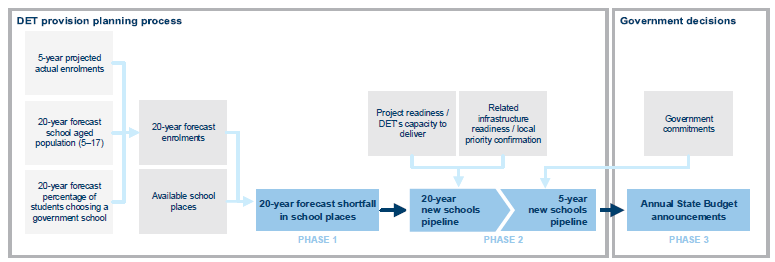
Source: VAGO.
In the first phase, DET determines the forecasted shortfall in school places for the next 20 years based on forecast enrolments compared with available school places—see Section 2.3.1. In the second phase, DET prepares the new schools pipeline (the pipeline) for the next 20 years, which it then refines to identify the priority list of schools for the next five years—see Section 3.2.2. In the third phase, government determines the schools that will be funded through annual State Budgets.
3.2.1 Predicting shortfalls in available school places
To determine the likelihood of future shortfalls in the school places being offered by existing schools, DET needs a reliable method of comparing available places with likely future demand. This involves forecasting future demographic patterns for each neighbourhood, the number of school-aged children, and the likelihood of parents choosing a public education. Forecasts should extend far enough into the future to allow enough time to build new schools if required.
DET predicts the likely future enrolment trends using modelling that forecasts 20 years into the future. DET has historically relied on demographic modelling from the annual statewide report Victoria in Future—the official state government projection of population and households.
In 2015–16, DET adopted a new approach that focuses on forecast enrolments rather than proposed sites for future schools. This has enabled DET to identify the priorities for new schools across the state based on the greatest forecast shortfall in school places.
The new forecasting model provides a more detailed analysis of the 20-year forecast enrolments in areas smaller than a suburb. It estimates the numbers of students in the age groups 5–11 years old and 12–17 years old who are likely to live in individual school catchments across Victoria. It takes into account the Australian Bureau of Statistics' census forecasts and likely future housing patterns in particular areas.
DET now has a more detailed picture of future enrolment trends, allowing it to better project future demand for school places. Figures 3B and 3C show the projected change in enrolment demand for schools, notably in the outer growth suburbs of Melbourne. These include Wyndham, Whittlesea, Cardinia, Hume, Casey and Melton, and regional cities such as Geelong, Bendigo and Wodonga. These suburbs are forecast to experience significant rise in pressure for school places over the next 10 years.
Figure 3B
Forecast change in numbers of school-aged children (5–17 years old) in Victoria, 2016–26
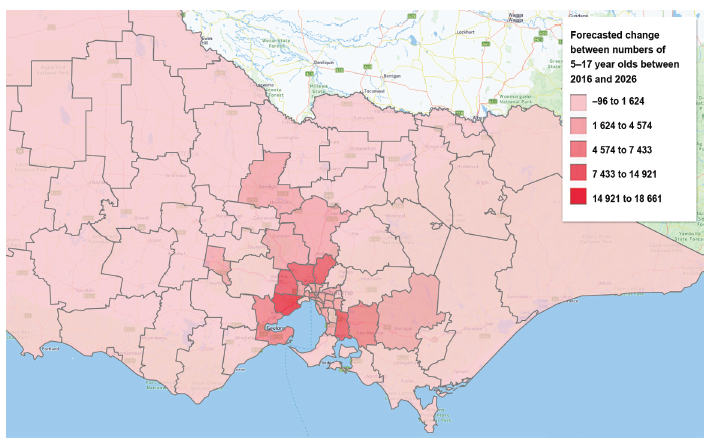
Source: VAGO, based on information from DET.
Figure 3C
Forecast change in numbers of school-aged children (5–17 years old), by small demographic planning units of Melbourne, 2016–26
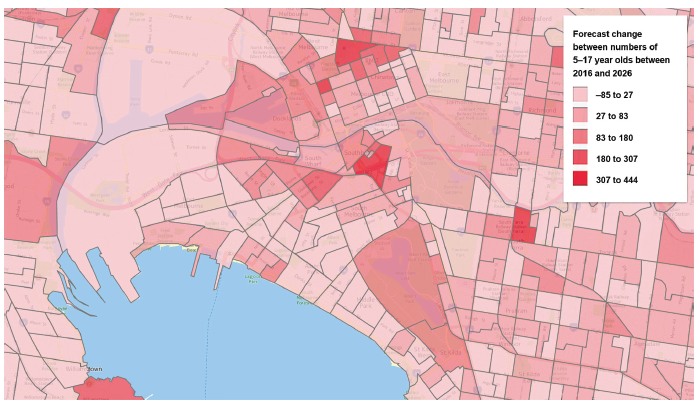
Source: VAGO, based on information from DET.
DET determines forecast enrolments in small geographic planning units by combining the forecasts of school-age children with the forecast proportion of students whose parents are likely to choose a public education. To determine this proportion, DET uses the greater of two metrics—the current proportion of students from a local area choosing to attend government schools, or the average proportion for areas of relative socio‑economic advantage and disadvantage.
As shown in Figure 1C, DET's most recent forecast of enrolments, conducted in 2017, shows that Victoria's government school population faces significant growth up to 2036.
DET supplements this 20-year forecast with five-year enrolment projections using the actual enrolments recorded within each school each year. This projection assumes the number of students who will progress through year levels at individual schools.
DET determines how many school places will then be required in surrounding neighbourhoods by comparing the 20-year forecast enrolments with places available within existing schools.
DET does not retrospectively test the accuracy of its forecasts and therefore does not know the reliability of its modelling over different time periods. DET could use the data on actual annual enrolments—which includes the home addresses of all students—to retrospectively test its forecasts, but it does not. As a result, DET could not confirm how the accuracy and reliability of its forecast enrolments or shortfalls in school places change over time. We raised this with DET in the Auditor-General's Report on the Annual Financial Report of the State of Victoria 2013–14.
Some local councils report that they have up-to-date information about planning decisions on future residential developments that could influence the number of students within a neighbourhood and therefore affect DET's forecasts of shortfalls in school places. It is important that DET works effectively with councils to ensure it tests the reliability and relevance of the planning advice it receives through its modelling, adjusting forecasts where relevant.
3.2.2 New school pipeline
The new school pipeline includes the priority schools required over the next 20 years to meet the greatest forecast shortfall in school places.
DET then considers factors that would affect these schools being built, in consultation with local councils, to determine a refined five-year pipeline of priorities. Factors include availability and suitability of land, readiness of planning and building permits, and local infrastructure. DET also considers the progress of developments that affect forecast population growth and changes to the proportion of parents choosing a public education.
DET incorporates into the five-year pipeline the new schools that government has promised to build through election commitments and other announcements. DET provides this pipeline to government as advice on the priority schools to build over the next five-years. DET does not assess the extent to which government commitments are meeting demand pressures.
Planning the location of schools
DET determines the optimal location of new schools in consultation with local councils. In the new metropolitan growth corridors, DET has effectively worked through the precinct structure planning process to collaboratively plan the likely location of future government schools in the next 10 to 30 years and beyond—see Section 3.4.
This process brings together a wide range of planning partners to agree on a developing area's long-term needs for community assets and how they will be distributed over the available area. This has enabled DET to plan strategically and effectively lock-in land—through the planning process—for schools to be developed at a later date.
Local councils in non-growth corridors are not benefiting from such a long-term, strategic planning process, except for some local councils in established urban renewal areas.
When enrolment numbers warrant further investigation, DET undertakes site-specific reviews to consider options for school sites and conducts school provision reviews for specific areas when directed by government.
Recent school provision reviews of the growing municipalities of Docklands, Banyule and Preston have shown the complexities of decision-making in these established areas, which experience high traffic congestion, dense developments and scarcity of land for future school sites.
DET is developing guidelines for established areas to inform its decisions. Particular issues these new guidelines should focus on include:
- weighing up costs and benefits of school locations
- weighing up costs and benefits of purchasing and managing land ahead of when it is required
- assessing particular school sites for access issues and barriers for students
- managing community expectations.
3.3 Responding to changing enrolments
Enrolments at individual schools change over time, principally due to population growth. They can also be affected by students choosing government schools outside their designated schools, where there are places available.
Enrolment pressure is particularly occurring at schools with better reputations. Over half of Victorian parents of school-aged children are currently choosing to send their children to schools other than their neighbourhood school. Currently, 52.3 per cent of government primary school enrolments and 53.3 per cent of government secondary school enrolments come from outside the local school catchment.
DET responds to these changes through its pipeline of new schools. However, before there are enough additional enrolments to warrant a school being built, DET needs to manage the increased enrolments at existing schools.
DET works with school leaders to identify the best option for making sure students can enrol at their local neighbourhood school, or—where there are places—at their preferred school. These options include:
- increasing the number of buildings to provide more enrolment places
- adjusting neighbourhood boundaries to increase or decrease a school's catchment area
- working with less popular schools to improve their performance and increase their demand for enrolments.
As enrolment demand may fluctuate over time, DET's asset choices need to be flexible, so that buildings can be relocated where and when they are required.
DET has effectively used its stock of relocatable buildings to respond to changing enrolment demand and the need for assets. Relocatable buildings can be removed when they are no longer needed at a school, and then refurbished and reassigned to another school.
DET annually considers the individual asset needs of schools to accommodate changes in enrolments.
DET aims for the relocatable building program to make up between 15 and 25 per cent of an individual school's buildings as demand changes. This enables DET to respond to short-term peaks and troughs in demand at individual schools.
3.4 Co-planning
The government has committed to exploring possibilities for strategically investing in multi-use, shared and co-located facilities. Such investments can deliver mutual benefit to communities and schools through schools using community assets and communities using school assets.
Local councils have an important role in community development and are key planning partners for schools. Neighbouring schools can also become partners in sharing assets across a region and with other service providers.
Planning partners need sufficient time to conduct their own planning and budgeting processes. As shown in Figure 3D, local councils have four-year planning and budgeting processes through their council plans and strategic resource plans.
However, government provides funding for new schools on an annual basis through State Budgets. This annual allocation, in combination with government's selection of new schools outside of DET's prioritisation process, means that DET is unable to pre‑empt government decisions on which new schools will be funded.
As a result, DET only consults on the design of new schools after budgets are approved and announced in the annual May State Budget. DET is then required to meet tight deadlines to make sure the school is built in time for when it is required to open.
Figure 3D
Planning cycles of co-planners

Source: VAGO.
While DET does consult with local councils in growth areas on potential school sites and on their annual growth forecasts, the opportunity for co-planning on the design of facilities with local governments is typically limited to three to six months. Project delivery schedules can, at times, extend this time frame.
This is a significant hurdle to achieving the benefits of well-designed co-planned facilities. Such tight time frames are disincentives for genuine collaboration and inhibit planning partners from strategically budgeting for future investments.
DET has proposed to government a five-year investment planning process to enable co-planning.
Infrastructure Victoria's 30-year strategy, completed in 2016, highlights the need to provide planning partners with more time to plan and collaborate. It recommends that every year DET should publish shortfalls in school places and five-year investment priorities for new and upgraded government schools. This will require a commitment from government to allocate funding on a five-year basis.
Although the government determines its priorities for investments annually, DET's release of forecast shortfalls of school places would provide sufficient transparency to enable co-planners to be informed of the relative priorities and likely timing of new schools in their areas. Local councils have also advised us that they would like DET to introduce a planning phase that would enable the design of multi-use, shared and co‑located facilities to be initiated well before new schools are funded through State Budgets. This would enable them to strategically plan and budget for potential future co-investments.
Release of this information would also help incoming governments to assess the areas of greatest need for new schools when considering specific election commitments.
Without an extension of time frames for planning, the ability for DET and planning partners to collaborate and co-plan efficiently will continue to be constrained.
4 Managing existing school assets
The Victorian Government's Asset Management Framework and international asset management standards consistently identify that effective management of assets involves knowing the type and nature of the assets being managed, knowing the state that they are in, quantifying what needs to be addressed, and prioritising available funds to address identified and unexpected problems.
Well-designed maintenance programs can extend the life of assets and improve the efficiency and cost-effectiveness of asset management in the long term. As shown in Figure 4A, a program that prioritises proactive maintenance—scheduled maintenance activities—can keep assets in good working condition and avoid breakdowns.
An effective maintenance program can reduce reliance on emergency contingencies and avoid the build‑up of maintenance backlogs—maintenance that is postponed until funding is available.
Figure 4A
The maintenance efficiency spectrum

Source: VAGO, based on the National Centre for Education Statistics.
This Part of the report looks at how effectively the Department of Education and Training (DET) is managing its existing school assets.
4.1 Conclusion
Since our last audit in 2013, DET has made considerable progress in managing Victorian government school assets. DET has improved its processes to routinely and accurately identify the assets it controls and is objectively allocating its centrally managed maintenance funds to assets in greatest need of repair.
DET is also effectively delivering projects to address the backlog of maintenance identified in the 2012 condition assessment it conducted on all of its existing school buildings. DET plans to improve the way it routinely assesses the condition of these assets through the introduction of a rolling facilities evaluation, which is expected to start in 2017. This information will build on the 2012 condition assessment and inform ongoing priority maintenance projects across Victoria.
However, school maintenance continues to be funded at levels below DET's assessment of industry standards. Without sufficient funding, schools will continue to postpone much-needed repairs and will struggle to maintain their assets effectively.
4.2 Identifying and registering assets
The Victorian Government's practical reference guide for asset managers is provided in the Asset Management Series (AMS). The AMS specifies that 'entities shall establish and maintain management processes to regularly monitor and assess the assets under their control'. It states that accurate asset recording, valuation and reporting is critical for decision-making about assets. It notes that entities should establish a program to review assets every five years and to review these programs annually.
Since 1994, the Financial Management Act 1994 has required DET to establish an asset register and maintain up-to-date asset information.
In 2014, DET adopted a central asset management information system to record all information about its assets. The system categorises assets into buildings, arts facilities, sports facilities, car parks and the space an individual school is entitled to. The system also records the valuation of all assets in DET's land and building portfolio, and lists vacant land. Information on the condition of assets and the presence of asbestos is stored separately.
As discussed in Section 2.2.4, this system is currently limited because it excludes information on condition, asbestos, joint-use agreements, school maintenance activities and individual valuations of assets. This limits DET's ability to conduct integrated analyses on asset information to inform decisions. Currently DET must conduct separate analyses on different aspects of its asset holdings.
DET is working towards making the system a 'single source of truth' that provides comprehensive information about the portfolio's assets.
DET updates the information in the system when it builds, upgrades, buys or sells assets. Over several years, our financial audits have found errors in DET's register of assets, including errors relating to the number and type of assets and their value. The Auditor-General's Report on the Annual Financial Report of the State of Victoria 2013−14 provides more detail about this issue.
Following consultation with us, DET is implementing a series of improvements to ensure that the register is accurately updated including:
- manuals, policies and procedures
- training for staff
- improving its monitoring and assurance program.
DET's asset holdings and their value are confirmed at least once every five years by the Valuer-General Victoria.
4.3 Monitoring asset performance
The AMS specifies that 'protecting service delivery potential and addressing health and safety concerns are priorities when making decisions about asset use and maintenance. As such it is important that an asset's performance is appropriately reviewed and evaluated to ensure expected outcomes are being achieved'.
The AMS refers to performance measures including condition, utilisation and functionality. The state of asbestos in schools and compliance with relevant legislative requirements are also important considerations. Figure 4B shows DET's performance against the performance indicators in its Asset Strategy 2014–24 (asset strategy).
Figure 4B
DET Asset Strategy 2014–24 objective indicators
|
Objective indicator |
Performance indicator |
DET performance |
|
|---|---|---|---|
|
Functionality |
1 |
All schools are rated 3.5 out of 5 (or above) for functionality (5 represents international best practice) |
50 per cent of schools above or equal to 3.5 out of 5 (2016–17) |
|
Condition |
2 |
All schools are rated 3.5 out of 5 (or above) for condition (5 is the equivalent of a new asset) |
82 per cent of schools above or equal to 3.5 out of 5 (2016–17) |
|
3 |
All schools are deemed to comply with regulations |
Not monitored |
|
|
Efficiency |
4 |
Excess space across the asset base at 15 per cent of total space or less by 30 June 2024 |
Excess space at 31.3 per cent of school space (2016–17) |
|
5 |
15 per cent reduction in utilities consumption across government schools (gas, water and electricity) by 30 June 2024 (baseline at 30 June 2014) |
Electricity—5.1 per cent reduction (2015–16) Gas—33.2 per cent reduction (2015–16) Water—11.1 per cent reduction (2015–16) |
|
|
Access |
6 |
Access measure to be developed as a priority action of the asset strategy (may relate to travel time or capacity in growth areas) |
Indicator not developed |
|
Community inclusion |
7 |
100 per cent of new schools are planned with adequate consideration given to opportunities for co-location with community and/or early learning services |
Not monitored |
|
8 |
Joint-use agreement or formal partnership arrangement measure to be developed as a priority action of the asset strategy |
Indicator not developed |
|
Note: Figures for 2016–17 are as at March 2017.
Source: VAGO, based on data from DET.
Two of the indicators are yet to be developed—indicators 6 (access) and 8 (community inclusion). Two indicators are complete but are not being monitored—indicators 3 and 7. Indicator 3 refers to compliance, for which DET has a framework it uses to 'deem' that schools comply with regulations—see Section 4.3.3.
Indicator 7 refers to planning for co-located facilities. DET advised that the processes established for planning new schools require DET to consider co-location with community and early learning services. There is no objective measure to assess whether these processes satisfy the indicator, and DET does not monitor its performance against this measure.
The indicators that DET is monitoring are discussed below.
4.3.1 Functionality
The AMS specifies that the functionality of assets should be regularly reviewed to enable any significant impact on services to be identified. Regular review will also allow timely changes to be made to improve both service delivery and functional standards.
DET uses a proxy measure of functionality based on historical allocation of funds to individual schools over 60 years, per square metre of entitled space. This method of measuring functionality is based on the assumption that schools receiving higher levels of maintenance funding will develop highly functional learning spaces that meet the needs of 21st-century learning methods.
This dollar figure is then converted into a functionality rating between 1 and 5, which changes annually due to the Valuer-General Victoria's valuation index. A rating of 3.5 assumes the level of investment has resulted in an acceptable functional standard. Currently a 3.5 rating is equivalent to $2 111 per square metre.
DET's functionality measure has limited relevance to how well suited an asset is to the activities and functions it supports. We do recognise, however, that this proxy measure serves another purpose of enabling DET to prioritise funding, as discussed in Section 4.5.2.
DET's asset strategy identifies a target of all schools being rated 3.5 or more out of 5 for functionality, with 5 being international best practice.
Based on the proxy financial measure, DET has increased the number of schools with an average functionality rating above or equal to 3.5 by 3 per cent since 2012–13, as shown in Figure 4C. However, half of schools remain below its 3.5 out of 5 target.
Figure 4C
DET performance: percentage of schools with a functionality rating above or equal to 3.5 out of 5, 2012–13 and 2016–17
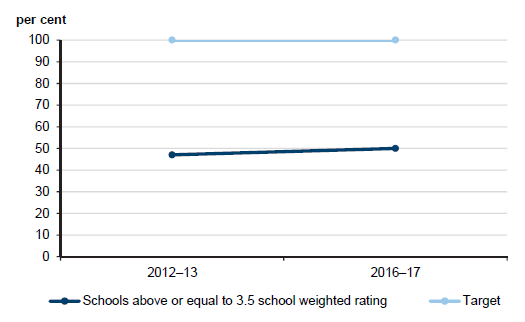
Source: VAGO, based on data from DET.
4.3.2 Condition
Condition rating
The AMS highlights the importance of knowing the condition of assets and provides guidance to agencies for establishing robust condition assessments. It explains that assets need to be maintained in a condition that is adequate for the purpose for which they are intended, and assessments should be relative to the service delivery objectives.
DET conducted the first comprehensive condition assessment of Victoria's government schools in 2012. Although the assessment had limitations, it currently provides the most accurate information on the condition of these assets.
The assessment was informed by a five-banded rating scale ranging from 1 (poor) to 5 (excellent), as shown in Figure 4D. It assessed separate building elements, such as windows, roofs, floors and internal walls, which were averaged at a building and school level.
Figure 4D
2012 asset condition assessment rating scale

Source: 2011–12 Condition Assessment of all State Schools in Victoria.
The assessment was guided by minimum acceptable condition thresholds for different types of buildings as set out below:
- core buildings (spaces for teaching, learning and administration)—3.25 (fair)
- non-core buildings (storage facilities, covered walkways, fences)—2.75 (fair)
- site infrastructure (storm water systems, septic systems, utilities)—3.25 (fair).
These thresholds were considered reasonable at the time, given the condition of government school buildings, and the funding needed to bring them up to good condition. All assets at or below these thresholds were classified as part of the maintenance backlog requiring repair or replacement.
The assessment concluded that inadequate cleaning of rainwater gutters and the extent of leaking roofs and tripping hazards demonstrated that preventive maintenance had been neglected and not given the attention it required. The assessment also raised concerns about flood mitigation measurements and stormwater drainage. A DET review in 2012 further emphasised that school maintenance projects were highly reactive rather than planned or preventive.
DET's building condition profile at the time of the review is shown in Figure 4E.
Figure 4E
Building condition profile at 2012
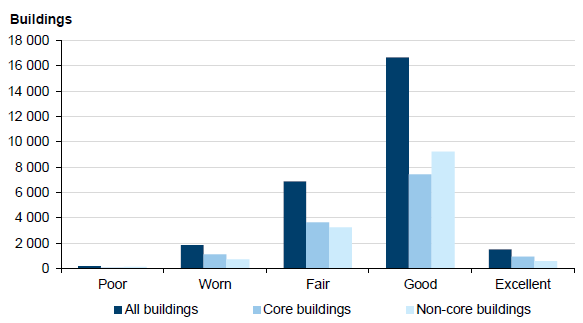
Note: Figures for site infrastructure were not defined in the final report.
Note: The condition assessment considered individual elements, and the results were then used to calculate the average weighted condition at building level.
Source: VAGO, based on 2011–12 Condition Assessment of all State Schools in Victoria.
DET intends to increase the threshold for the minimum acceptable condition over time as the condition of buildings gradually improves. DET's asset strategy identifies a target for every government school to be rated at an average 3.5 out of 5 or above by 2024—a good or excellent condition.
DET is currently developing a rolling facilities evaluation (RFE) to routinely update the condition information for its school assets. The RFE will begin in 2017 and will assess the condition of 20 per cent of schools every year. Once this evaluation is in place, the condition of each school will be updated every five years. The proposal is sound, based on current technology.
DET will have completed its first round of the assessments of all schools in 2021, 10 years after the 2011–12 assessment. This will give DET a regularly updated picture of the condition of all of Victoria's government school buildings.
Until the RFE is implemented, DET will not know the extent to which school assets have continued to degrade since the 2012 condition assessment, and to what extent the backlog has grown.
Compliance
The AMS requires entities to comply with the requirements of relevant legislation. DET does not monitor compliance of school assets with relevant legislation. Instead, it has a system in place to 'deem' that schools are compliant.
Compliance of new school assets
For new facilities that are built, renovated or refurbished, DET relies on an independent certification of compliance issued by building surveyors accredited by the Victorian Building Authority. This provides assurance of facilities' compliance with regulations at the time of the works being completed, in line with the Building Act 1993, the Building Regulations 2006 and the National Construction Code. Schools cannot occupy the buildings until a certificate of compliance has been issued by the building surveyor.
Ongoing compliance
For existing facilities, DET is guided by the Victorian Occupational Health and Safety Act 2004 (the OH&S Act) and the Commonwealth Disability Discrimination Act 1992. The obligations that arise from these Acts are addressed as the need arises. DET is also guided by its Occupational Health and Safety (OH&S) Management System, which includes an OH&S policy, hazard management procedures, an OH&S risk register, an OH&S activities calendar and inspection checklists.
DET has devolved the responsibility for managing compliance with these two Acts to schools. The OH&S Act outlines responsibilities for those who have management or control of a workplace. For schools, these responsibilities rest with the principal, who must address issues as they arise.
DET provides funding to schools and expects that the funds will be used for the range of works required to improve health and safety at schools.
DET's ultimate accountability for schools under the OH&S Act was reinforced in 2012 by WorkSafe Victoria. Worksafe Victoria found some school principals were breaching their OH&S requirements for managing asbestos. At the time, WorkSafe Victoria considered that DET had failed to be sufficiently accountable for asbestos in schools. DET has since been working to improve its accountability for asbestos.
Although this is not part of DET's asset strategy objectives, the government has committed to all schools being asbestos-free by 2020. Since 2012, DET has removed all identified high-risk asbestos—A1 and A2 categories—from Victorian government schools. All buildings containing identified asbestos have also had labels applied at their entrances.
DET is responsible for a suite of centrally managed programs that act as a safety net should issues arise that schools do not have the capability or financial means of addressing—such as asbestos, accessibility issues, emergency maintenance and compliance works. The compliance works include hydraulic fire safety systems, prevention of falls and underground petroleum storage systems.
DET also provides schools with tools and training for improving their management of OH&S issues.
DET promotes best practice design for new buildings and upgrades. Since 2000, DET's Building Quality Standards Handbook (BQSH) has identified the design, materials and construction practices that are considered to be best practice.
DET has engaged an independent contractor to monitor alignment with the BQSH and other relevant building standards for capital works and planned maintenance projects with a total estimated investment over $200 000. DET does not assure itself of alignment for capital works and planned maintenance projects under this amount.
4.3.3 Efficiency
Excess space
The AMS specifies that agencies should identify how intensively assets are being utilised and should take action to address under-utilisation, either through improving their use or redeploying assets.
The rate of utilisation of a school is based on the building space that each school is entitled to and the number of students who are enrolled at the school.
This entitlement is determined using an outdated 20-year-old formula, which allocates space for buildings such as classrooms, office spaces and gymnasiums based on the number of students enrolled at the school. If a school's space is greater than its entitlement, it is called excess space. This space is considered to be under-utilised by the school.
The entitlement formula no longer reflects the complexity and diversity of asset allowances—such as additional space requirements for disability access—that have been introduced since the formula was adopted. DET is therefore reviewing the entitlement formula and will also review, if necessary, the way it defines, calculates and tracks utilisation rates. The review is considering space associated with new curricula, outdoor learning spaces, integration of special education students, and community facilities. It is also considering how to provide flexibility for less common situations.
DET monitors how intensively its assets are being used by tracking enrolments, the amount of space a school is entitled to and the excess space present.
DET's asset strategy identifies a utilisation target to reduce the excess space across the asset base to 15 per cent by 30 June 2024.
The total amount of excess space increased from 15 per cent to 38 per cent between 2007 and 2012. This was the result of a significant boost in investment in school assets by the Victorian and Commonwealth governments through the Victorian Schools Plan and the Commonwealth Government's Building the Education Revolution initiative. These programs resulted in a large number of new facilities and buildings being built that did not align with the space schools were entitled to under the current formula.
DET effectively addressed utilisation issues since then. It has a stock of relocatable buildings that it can deploy to schools in need of additional classrooms. It is also demolishing poor-quality excess buildings and reconfiguring space during capital upgrades.
DET has achieved a steady reduction in excess space since 2012–13, down almost 7 per cent. As shown in Figure 4F, around one-third—31.3 per cent—of school space is currently classified as excess space.
Figure 4F
DET performance: excess space
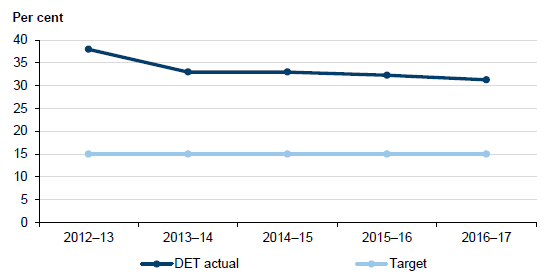
Note: 2013–14 and 2014–15 figures are as reported by DET.
Note: 2016–17 figure is based on indicative 2017 enrolments from August 2016 and asset data as at 30 December 2016.
Note: 2015–16 figure is based on asset data as at 31 December 2015.
Source: VAGO, based on data from DET and 2012–13 data from VAGO audit Implementation of School Infrastructure Programs (2013).
Utilities consumption
According to the AMS, typical indicators for tracking asset performance can include measures such as an asset's energy consumption.
DET tracks the efficiency of schools by monitoring their consumption of electricity, gas and water. DET uses the consumption data recorded by utility companies to assess its performance against the asset strategy target.
DET's asset strategy identifies a target of 15 per cent reduction in utilities consumption (gas, water and electricity) across government schools from 30 June 2014 to 30 June 2024. As shown in Figure 4G, since 2013–14 DET has achieved a 5.1 per cent reduction in electricity consumption, an 11.1 per cent reduction in water consumption and a 33.2 per cent reduction in gas consumption. This means DET has already met its target reduction for gas consumption.
Figure 4G
DET performance: total utilities consumption across government schools, 2012–13 to 2015–16
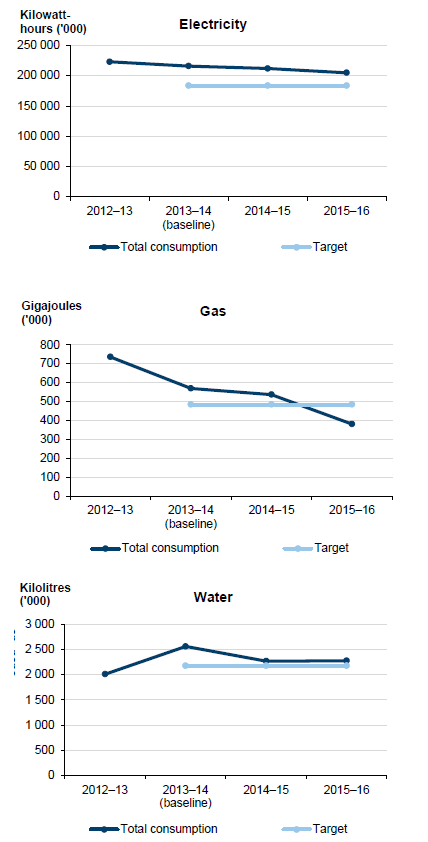
Source: VAGO, based on data from DET.
4.4 Addressing the backlog
The AMS specifies that entities must plan for asset maintenance to enable them to take targeted action in a timely and cost-effective manner.
DET's 2012 condition assessment identified a backlog of maintenance that had been postponed by schools until funds were available. This assessment estimated that about $420 million would be needed to clear the backlog and bring the average condition of Victoria's school buildings and site infrastructure up to the minimum acceptable condition threshold. This figure includes an estimated:
- $360 million for core buildings
- $50 million for non-core buildings
- $10 million for site infrastructure.
Reviews and audits at the time concluded that this was due to a combination of insufficient maintenance funding and ineffective maintenance programs. DET has since established a process to systematically and strategically address the backlog and raise standards for the condition of school assets.
DET is addressing the maintenance backlog through two main programs:
- capital works program—projects involving the construction of new school facilities or the reconfiguration of existing school facilities
- planned maintenance program—projects involving the refurbishment of existing school facilities, which do not involve changes to the building, room configurations or usage.
Approximately 34 per cent—or $143.4 million—of the estimated $420 million backlog remains. DET anticipates that it will complete all the works identified in the backlog by 2018–19, subject to State Budget allocations.
DET is using the completed repairs and upgrades as a proxy measure of the condition of school buildings. DET raises the condition to a 5 when a building is replaced, or 4 when it is repaired or renewed.
Based on this proxy measure, DET has increased the number of schools with an average condition rating above or equal to 3.5 by 13 per cent since the condition assessment in 2012–13, as shown in Figure 4H. At March 2017, 82 per cent of schools were estimated to be in a good or excellent condition.
Figure 4H
DET performance: percentage schools with a weighted condition rating above or equal to 3.5 out of 5, 2012–13 and 2016–17
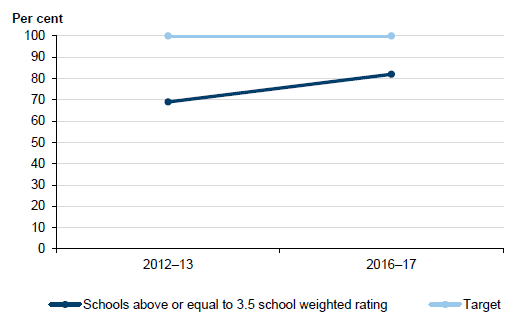
Source: VAGO, based on data from DET.
DET has no up-to-date assessment of the backlog that has developed since 2012.
4.4.1 Delivery of capital improvements
DET's delivery of capital improvements and new schools has improved since 2011−12.
From 2008−09 to 2011−12, DET's delivery of capital works exceeded its budget by around 1 per cent. Between 2012−13 and 2014−15, DET's capital works were delivered within budget or up to 5.4 per cent below budget, as shown in Figure 4I.
DET attributes this improvement to project contingencies not being fully utilised and favourable tender results.
Figure 4I
DET's adherence to budgets for its capital works programs, 2008–09 to 2014–15
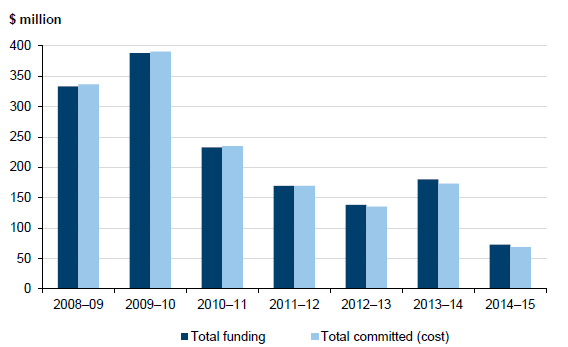
Note: Costs exclude portfolio management and DET internal costs.
Source: VAGO, based on data from DET.
Although DET's delivery of individual projects by their forecast delivery date has declined since 2007–08 overall, DET has significantly improved its delivery within three months of the forecast delivery dates.
As shown in Figure 4J, from 2007–08 to 2010–11, DET delivered less than 75 per cent of projects in its capital works programs within three months of their original forecast delivery date, but from 2012–13 to 2014–15 its project delivery improved to between 85 and 95 per cent. Although delays remain, DET has reduced the length of the delays.
Further, in 2014–15, DET delivered 68 per cent of projects on time or within 15 days of their original forecast delivery date. This is an improvement on 2013–14 when DET delivered only 65 per cent of projects on time or within 15 days of the original due date.
DET attributes the delays in delivery to the introduction of new processes for tracking projects and the requirement for asset management plans to be completed before capital works are finalised.
Figure 4J
Percentage of individual projects within DET's capital works program delivered by their original forecast delivery date, 2007–08 to 2014–15
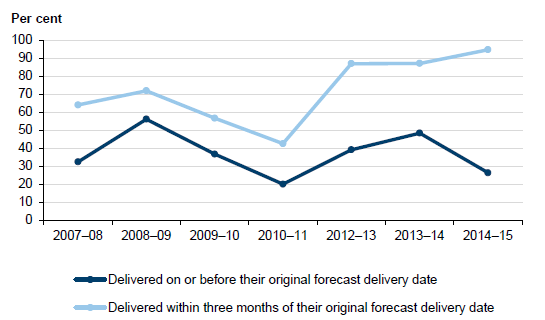
Note: Original forecast delivery dates were not set for 2011–12 in the Victorian Government Budget Paper 4.
Source: VAGO, based on data from DET.
4.5 Prioritising funding
DET has an objective approach to funding maintenance. It has prioritised proactive maintenance by consistently allocating around two-thirds of the available maintenance funding to schools since 2006–07 through its student resource package (SRP). In that time, the highest proportion of maintenance funds allocated to schools was 70 per cent in 2008–09 and the lowest was about 55 per cent in 2007–08.
Figure 4K shows how DET has distributed its maintenance funding since 2006–07. Historically, DET has centrally managed 35 to 40 per cent of the maintenance budget for high-priority maintenance and capital works programs, emergency maintenance, asbestos removal and reinstatement of damaged assets.
Figure 4K
How DET allocates government maintenance funding, by program
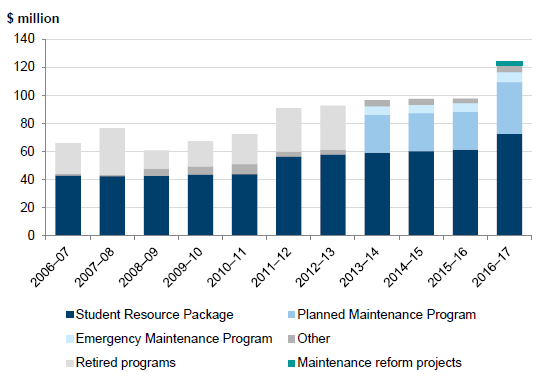
Source: VAGO, based on data from DET.
4.5.1 Allocation to schools
Maintenance funding should ideally be based on the maintenance needs of an asset, as determined by an asset life cycle costing model.
DET devolves a proportion of the maintenance funds it receives from the government each year. This is not based on life cycle costing models. Instead, DET distributes the schools-managed proportion of the maintenance allocation directly to schools through the SRP.
The SRP maintenance allocation is based on objective criteria, comprising:
- building age—25 per cent of the allocated funds
- building construction material—25 per cent of the allocated funds
- the school's entitled area (the physical space required for the number of students enrolled)—50 per cent of the allocated funds.
A weighting is also applied for rural schools to account for greater costs in remote areas. Schools are encouraged to use the funding to proactively maintain their assets and address maintenance issues as they arise.
This allocation is based on predetermined proportions rather than on the true costs of managing assets. Using a life cycle costing model would enable DET to identify the actual funding needs for school maintenance.
Funding excess space
As discussed in Section 4.3.2, DET has established a program to reduce the amount of excess space in Victorian government schools. DET coordinates the removal of excess space through its program of relocatable buildings and by demolishing excess assets in poor or worn condition, as shown in Figure 4L.
Figure 4L
How DET responds to excess space

Source: VAGO.
If a school still holds excess space after relocatable buildings have been removed and poor-quality buildings have been demolished, this excess space is likely to be found in existing permanent buildings.
DET records excess spaces as percentages and not as particular assets. Schools are responsible for identifying which buildings—or portions of buildings—are to be considered as excess. Schools are also responsible for determining whether to use this space.
DET distributes the available funds to schools for maintenance on the basis of 25 per cent being allocated based on age and 25 per cent based on building materials. Schools with excess space do not receive the 50 per cent allocation of funds—based on the school's entitled area—for the proportion of the assets that are in excess of what the school is entitled to. As the entitled area is determined by the number of students attending a school, this partial funding is based on the assumption that, if a school has fewer students, these spaces are not necessary to use and therefore should not be degraded through use.
DET's funding model directs maintenance funding to where students are rather than where buildings are. DET provides schools with maintenance funding commensurate with the space it considers the school requires for the number of students it has. While allowances are made for fixed costs, a consequence of this approach is that schools with a large amount of excess space receive less funding per square metre.
Under the devolved model, schools make decisions on how their space—including excess space—is used, including whether it is sectioned off or used by the school or community. Schools have the responsibility of funding any shortfall in maintenance for excess permanent spaces. If schools choose to use these spaces, it is expected that they would require more maintenance.
DET encourages schools to address the funding shortfall from other sources. Where this excess space is being used by third-party users, maintenance funding can be sourced through joint-use agreements. Although DET is generally a signatory of these agreements, DET has no oversight of how the schools use any funding associated with these agreements.
DET has no oversight of whether schools are maintaining their excess space or whether the allocated funds that DET provides are being spread thinly across all school facilities. DET also has no oversight of the extent to which schools are seeking community investment, such as through fundraising activities, to meet their maintenance needs.
DET's reforms aim to improve its oversight of school maintenance activities. DET's review of the entitlement calculations may also result in changes to how excess space is defined.
4.5.2 Allocation of funds to priority projects
DET uses centrally managed funds to target priority projects identified in the 2012 condition assessment. DET has established an equitable, objective and transparent approach to allocating these funds based on the needs of the assets. This is intended to provide a reliable, transparent and objective methodology to assure schools that the system is fair.
The methodology is based on condition and functionality—measured as historical investment. The condition and functionality of schools are averaged and categorised into four quadrants using these two measures. The threshold for both acceptable condition and functionality is 3.5 out of 5.
As shown in Figure 4M, schools in the green quadrant are in good condition and have high functionality. The numbers of schools in the green and yellow quadrants have increased between 2012–13 and 2016–17, indicating an overall improvement in condition. Schools in the red quadrant are in poor condition and have low functionality—these schools are the priority for future funding, with the aim of progressively returning all schools to the green quadrant.
Figure 4M
Number of schools by the condition and functionality of their assets, 2012–13 to 2016–17
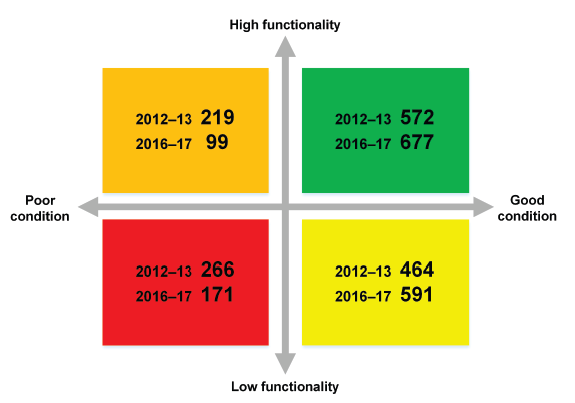
Source: VAGO, based on data from DET.
DET currently advises the government on which schools should receive funding for projects to address the backlog as part of the annual State Budget process.
As part of DET's reform package, DET aims to move from an annual State Budget investment cycle to a five-year investment cycle based on this methodology. The aim is to have a cyclical and annually updated plan that provides certainty and transparency about future funding decisions. This will enable schools to strategically plan maintenance activities. It will also allow DET to target schools most in need of capital investment.
It is a considerable improvement on DET's previous funding model, which relied on schools applying and lobbying for funds. However, the five-year investment plan is yet to be adopted through the State Budget. DET therefore continues to receive funding on an annual basis through Budget allocations.
Maintenance funding—meeting industry standards
Victoria's government schools have historically been funded at a rate well below industry standards for maintenance. Victoria's maintenance funding has ranged between 0.7 and 1.2 per cent of the asset replacement value (ARV), as shown in Figure 4N.
DET determined that annual investments of 2 to 4 per cent are typical industry allocation ranges. The lower ARV percentages are considered to be suitable only for assets that are in a superior condition and that can easily be maintained with minimal funds. When assets are degraded, more money is needed to bring them up to a suitable standard, so they can then be effectively maintained at a lower cost.
Figure 4N
School maintenance funding as a percentage of ARV compared to industry standard
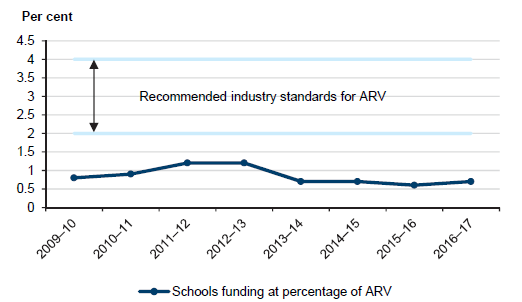
Source: VAGO.
DET's 2012 condition assessment found that 34 per cent of school buildings required repair or replacement. It recommended greater investment of funds to bring them up to a standard that could be maintained. It recommended the annual maintenance investment should be $270 million—2 per cent of the ARV of the portfolio at the time— allowing 1.5 per cent for preventive maintenance and 0.5 per cent for unplanned or unforeseen repairs and replacements.
In 2016, a DET assessment found that, due to the poor condition of school buildings, extra funding was needed to bring the condition of buildings up to a standard that could be preserved through ongoing preventive maintenance. The report recommended funding at a rate of 2.5 per cent of ARV until minimum thresholds were met. After that point, preventive maintenance would be more cost-effective at a lower rate.
The 2016−17 State Budget increased the allocated funding for maintenance from 2015−16 to a rate of 0.7 per cent of the current ARV. This will amount to $200 million over four years—equating to $50 million per year—in additional maintenance funding.
For the past 10 years, funding for maintenance has been well below industry standards, which has contributed to the degradation of school buildings. The funding is also well below the funding needed to bring assets up to a condition that will be more cost-effective to maintain.
Some schools are making up the shortfall for the costs of asset maintenance. In our 2014 audit, we found that during the previous year, parents contributed almost $52 million to Victorian government schools. This is almost $35 000 per school. DET has no oversight of the extent to which these funds have been used for maintenance.
Without adequate funding, schools will continue to postpone much-needed repairs, prioritise reactive rather than preventative maintenance, and struggle to maintain assets effectively.
Appendix A.Audit Act 1994 section 16—submissions and comments
Introduction
We have professionally engaged with the Department of Education and Training throughout the course of the audit. In accordance with section 16(3) of the Audit Act 1994 we provided a copy of this report or relevant extracts to this agency, and requested its submissions and comments. We also provided a copy to the Department of Premier and Cabinet.
Responsibility for the accuracy, fairness and balance of those comments rests solely with the agency head.
The full response from the Department of Education and Training is provided below.
RESPONSE provided by the Secretary, Department of Education and Training


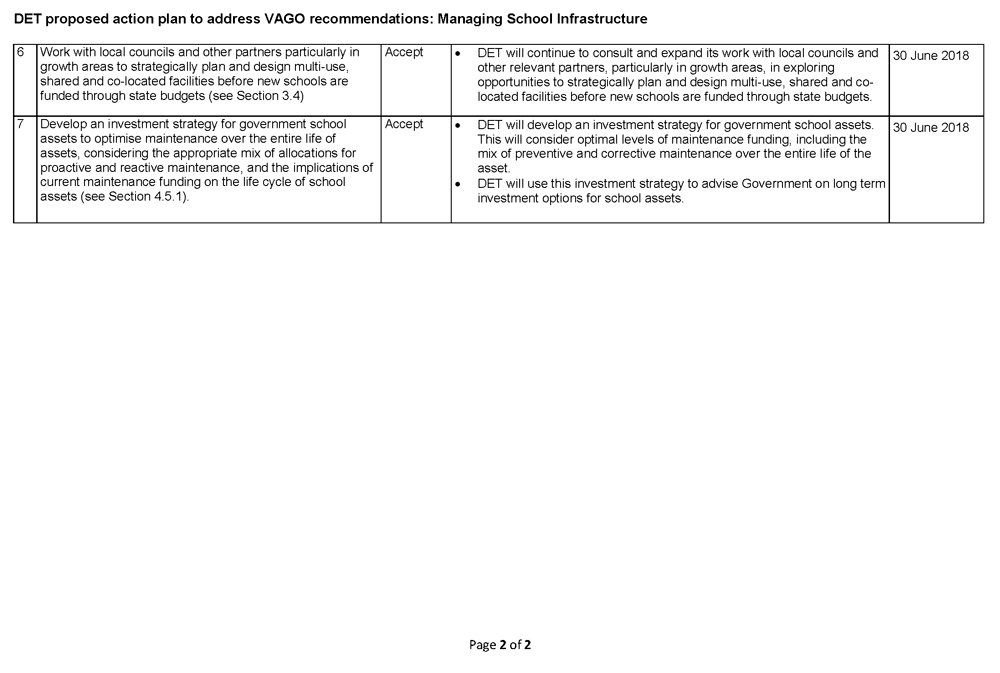
Appendix B. Department of Education and Training asset reforms
The Department of Education and Training's (DET) asset reforms focus on four key areas—funding, capability, accountability and efficiency. These initiatives should give DET adequate oversight of schools' asset management and enable it to fulfil its accountability to the Minister for Education. Figure B1 outlines the key reforms in each area.
Figure B1
Key DET reforms
Reform |
DET action completed |
DET action in progress |
|---|---|---|
Accountability |
||
Asset management planning |
DET implemented its 10-year Asset Strategy 2014–24 to provide long‑term strategic planning for school assets. |
DET is progressively requiring all schools to develop a five-year asset management plan (AMP). About one-third of schools already have an AMP focused on managing capital or planned maintenance projects identified by the 2012 condition assessment. All schools will have AMPs focusing on preventive maintenance by 2021. DET intends to require schools to prepare AMPs after a condition assessment being completed as part of the rolling facilities evaluation. If a school has previously completed an AMP, this will be updated. DET is updating a template and guidelines. These aim to inform schools about how they can proactively maintain their assets. |
Information management systems |
DET has adopted:
|
DET is rolling out an improved system for overseeing asset management and expenditure by schools. The asset management information system was first used in 2014 and is being improved to incorporate a wider range of information so it can act as a central register of information on school assets. The system will enable DET and schools to track their activities and maintenance spending. A pilot phase of the rollout will commence in 2017 and, following this pilot, the system will be rolled out to all schools. The timing of this will depend on the results of the pilot phase. DET intends to ensure schools use the system, so it will develop a policy that outlines the mandated requirement. DET is yet to determine how it will enforce this requirement. |
Principals' accountability model |
DET sets out the major managerial functions of a principal in their employment contracts, including to 'develop, implement and manage a plan for the development and general maintenance of school buildings and grounds'. DET has not defined the plan referred to and therefore does not consistently hold principals to account. |
DET is currently reviewing its accountability mechanisms in relation to principals. |
Responsibility of school council |
DET relies on the existing legislative powers and responsibilities of school councils to provide accountability for the operation of schools and management of their assets. |
None. |
Funding |
||
Long-term funding certainty |
None. |
DET continues to develop and propose to government a five-year investment plan which identifies required expenditure over the period. This is anticipated to provide certainty and transparency about future funding, to allow DET and schools to plan strategically. |
Objective method for allocating funding |
DET has an objective methodology for allocating student resource package funding to schools for preventive maintenance. It is based on building age, building material and the physical space required for the enrolments at a school. DET adopted an objective methodology for prioritising funding for capital works in 2014. It is informed by a combination of condition and functionality. |
DET is establishing a rolling facilities evaluation to periodically reassess the condition of each school, to inform future priorities for investment through the planned maintenance and capital works program. |
Funding level industry benchmark |
None. |
DET annually advises government on the maintenance investment needs for schools. |
Capability |
||
Resources |
Since 2012, DET has developed a suite of resources to assist principals including:
|
DET is:
|
Training |
In 2014, DET introduced a professional development program for school principals and managers, covering asset and financial management. This included:
|
DET will require schools to complete training when an updated AMP is completed. |
Local support |
Since 2014, DET has provided local support to schools by:
|
None. |
Efficiency |
||
Reduce excess space |
Since 2012, DET has established a process to reduce excess space, to allow schools to focus maintenance funding on spaces that are used for school purposes. DET has removed excess space by relocating excess buildings, demolishing excess space of poor quality, and reconfiguring existing buildings to align with schools' space entitlement. |
DET is updating the AMP template to outline how schools can progressively plan to address excess space. |
Centralised programs |
DET has historically centrally managed approximately 40 per cent of the maintenance budget for high-priority maintenance and capital works programs, emergency maintenance, asbestos removal and reinstatement of damaged assets. |
DET has sought and received additional funds from government in 2016–17, to provide a greater safety net for schools and increase the targeting of maintenance funding to known areas of need, including those identified by the 2012 condition assessment. |
Source: VAGO.
